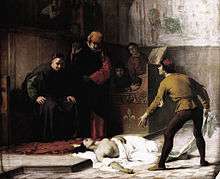Gonfaloniere
The Gonfalonier (in Italian: Gonfaloniere) was the holder of a highly prestigious communal office in medieval and Renaissance Italy, notably in Florence and the Papal States.[1] The name derives from gonfalone (in English, gonfalon), the term used for the banners of such communes.

In Florence, the office was known as Gonfalonier of Justice (Gonfaloniere di Giustizia) and was held by one of the nine citizens selected by the drawing lots every two months, who formed the city's government, or Signoria. In the papal states, it was known as Gonfalonier of the Church or Papal Gonfalonier.[2] Other central and northern Italian communes, from Spoleto to the County of Savoy, elected or appointed gonfalonieri. The Bentivoglio family of Bologna aspired to this office during the sixteenth century. However, by the year 1622, when Artemisia Gentileschi painted a portrait of Pietro Gentile as a gonfaloniere of Bologna, with the gonfalone in the background, the office had merely symbolic value.
References
- Viti, Paolo; Zaccaria, Raffaella Maria (1989). Archivio delle Tratte: Introduzione e inventario. Rome: Archivio di Stato di Firenze.
- "Gonfalonier: Medieval Italian Official". Encyclopædia Britannica. 23 November 2014. Retrieved 2 May 2015.